We are four women who are new to the game of golf. We connected through the game, and have become friends because of it. We love the game, and want to share our experiences in finding our way, and encourage and empower other beginners to take it on and seize every opportunity for joy in it.
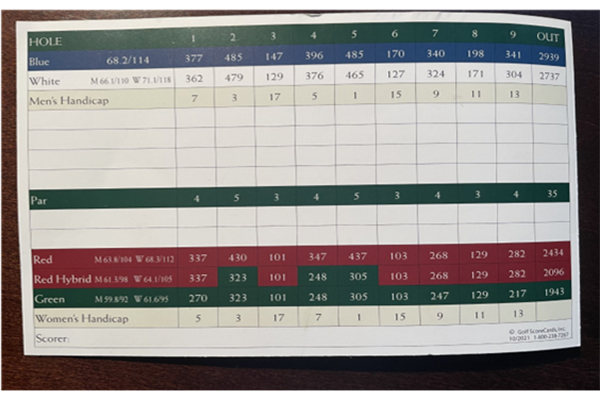
Reading a golf scorecard can seem tricky with all the numbers and terminology, but it’s easy once you learn the basics. Most golf courses will have printed scorecards you can pick up at the pro shop or in an enclosure at the first hole (usually looks like a mailbox). For the most part, when playing a round, a player counts the number of strokes taken on the hole and writes that number down in the box for that hole. At the end of the round, a player adds up the strokes from all the holes and that’s your score.
With scorecard in hand, we’ve found it helpful to keep a few things in mind.
Macarena: When I saw my first scorecard I was totally baffled by all the numbers – pars, distances, handicaps, etc. And everyone I saw who had them attached to their carts seemed to be filling in their cards as they walked from hole to hole without even thinking about it – all whilst I was trying to keep count of how many shots I had hit and then figuring out where to write my score. I’m sure the reason you get a pencil is that those beginners who mess up can correct their score as they go.
Another reason you always keep your partner’s score as well as your own is to verify each other’s score. Before you turn in your card you always compare your card with that of your partner, going over it hole by hole, along with the final tally. In fact, there is a space at the bottom of every scorecard which must be signed by yourself and your partner.
To make it easier, I highlight the tees I’m playing in order to see what distance I have to each hole. I also write down my partner’s name on the scorecard at check-in, so that I remember their name as I head off to the course. It is also a good idea to check your own course handicap before you arrive at the course (and make a note on your card) using the GHIN app, so that when you add up your score you can easily calculate your NET score by deducting your course handicap from the GROSS score.
When marking my card I have also found it useful to keep a record of how many putts I make on each hole, to see how much I need to practice in the future. Also, some golf competitions require you to post the number of putts, so it’s good to get into the habit of doing so.
I have kept every scorecard from every course I have played this last year, and when I play the same course I look at my last scorecard and compare my scores to see how I have improved (or not!). But, hey, that’s life as a beginner!
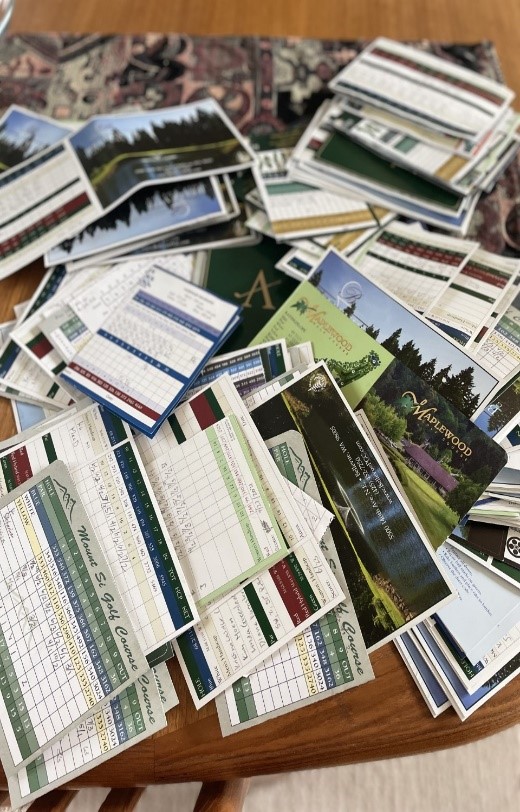
Johanna: The most important thing about scorecards is….remembering to get one! Walking from the first green to the second tee, there have been a few times I have looked down at my cart and realized I forgot to get a scorecard. Fortunately, there is usually a mailbox (or some type of box) holding blank scorecards in case you’re like me.
One thing I pay attention to on the card is the “par” score for the hole. I like to see how my score is measuring up, for example did I get a bogey (one stroke over par), double bogey (two strokes over par), par, or even a random birdie (one stroke under par).
Another way I use the card is to quickly jot down all of the names of the players in my foursome, so I don’t forget. It’s so easy to have an awkward Seinfeld situation where you’ve talked to somebody for two hours and don’t remember their name! Finally, if you’re new to the game and save your cards like me, you can look back and see the progress you’ve made. It helps on days you wonder if you should’ve taken up cycling.
Stephanie (@coldinseattle on TikTok): Oh, my scorecard…..it’s so exciting at times, and so depressing at others. Last season, when I joined the 9-hole group after a handful of lessons, I journeyed out with my first foursome for a round of golf. This was the first time I truly went out and kept my score. After a few holes, one of the ladies in the group looked at my card with scratch marks on it. She asked, “What is this mess?” I was embarrassed and told her these are my strokes. I had been keeping tallies for each hole. That’s how I kept track of all my strokes (and there were a lot of strokes!). As we approached the next tee, the group handed me a bead counter. Wow, what a lifesaver.
Now that I am seasoned golfer (one year in), my scorecard is nice and clean. I keep track of my strokes and putts; I make little notes on how I tee off (right, left, fairway). This lets me know what I need to work on. Am I consistently pulling right? This all helps when I go to my next lesson. (Also, the answer is yes, I’m always pulling right. Time for another lesson.)
I also keep track with little notes like “bunker” or “water,” and when I have a fantastic drive, I calculate and write down how long it was. As the year progressed, seeing the number go down hole by hole kept me in the game. I’m still inconsistent, but my handicap has gone down gradually. My advice is to always keep score and always post in GHIN. How else can you tell if you are improving?
Kristina (@k_love_90 on TikTok): In addition to score keeping and statistic tracking, there are so many good resources on a scorecard! I often consider the “hole handicap,” which is basically a difficulty rating for each hole relative to the others. The hole rated the “1” handicap is considered the toughest on the course and the one assigned “18” is considered the easiest on the course. Hole handicap can vary depending on which color tees you play from, so be sure to keep that in mind.
In terms of overall golf course difficulty, keep in mind that Course Rating and Slope Rating are difficulty numbers assigned to a golf course and are listed on the scorecard. Rating and Slope numbers go up when a course is more difficult. It’s a good reference point so that you can understand your score relative to the difficulty rating of the course.
Additionally, most scorecards have a course map, local rules and sometimes there is info about nearby retailers, services, restaurant discounts and other gems. I was playing a round last year on a course we’d never played before and our group got turned around, so out comes the scorecard and golf course map. We flipped it around, oriented ourselves, questioned the map several times and re-routed to get back on track (eventually).
Who We Are
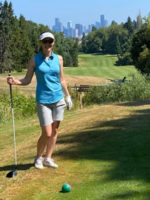
Johanna MacMichael: Prior to March 2021, I’d only played golf a few times with my husband in “scramble” games. During COVID, a neighbor friend recommended a women’s golf league and I started playing on a regular basis. I love this game! My handicap is 38.6.

Macarena Dearie: I was born in the UK, with the past many years living in various countries around the globe. I made a promise to my husband over 30 years ago that I would learn to play his beloved golf game if he learned to ski. And so here I am. My handicap is 40.0.
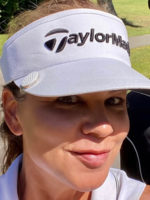
Stephanie Standifer: At 55 years old I started taking golf lessons during the COVID pandemic. My instructors encouraged me to play more regularly, so I joined my first 9-hole women’s league in the spring of 2021. My handicap is 26.4.
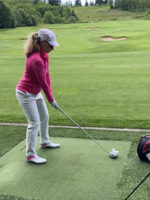
Kristina Laidler: I retired during the pandemic, so I’m returning to golf after years commuting and sitting behind a computer keyboard. I always wanted to play more, and better, golf but did not have the time until now. My handicap is 26.3.

